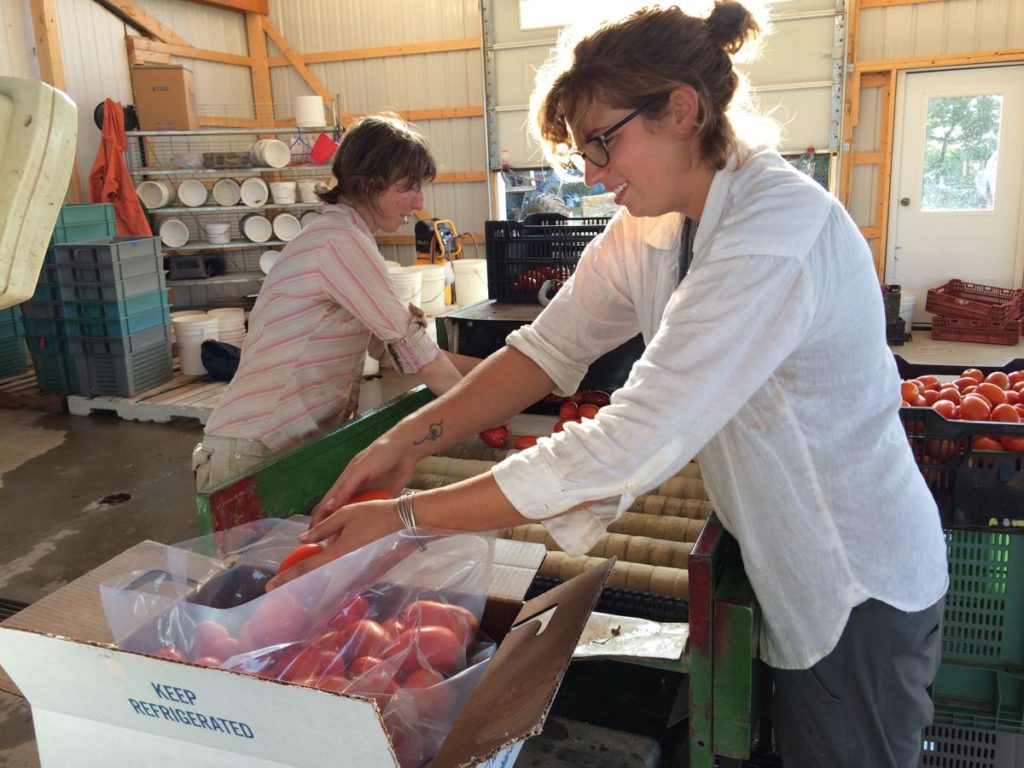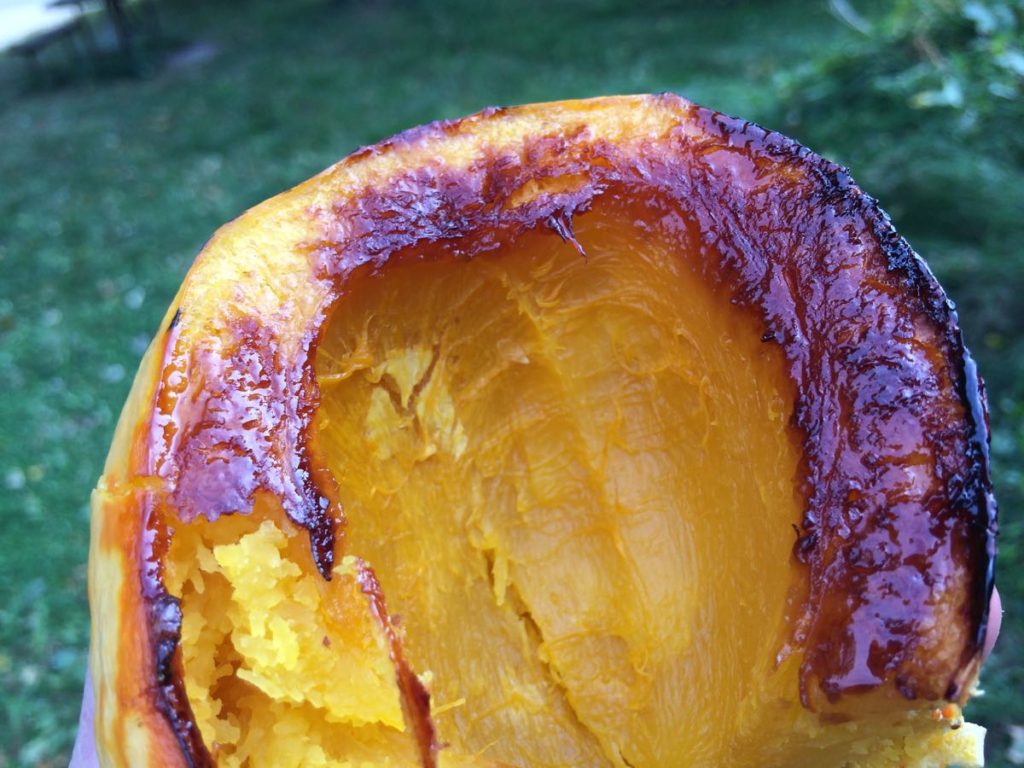Week #19, Sept 21 2017
- On: September 20, 2017
 0
0
Scenes from the week
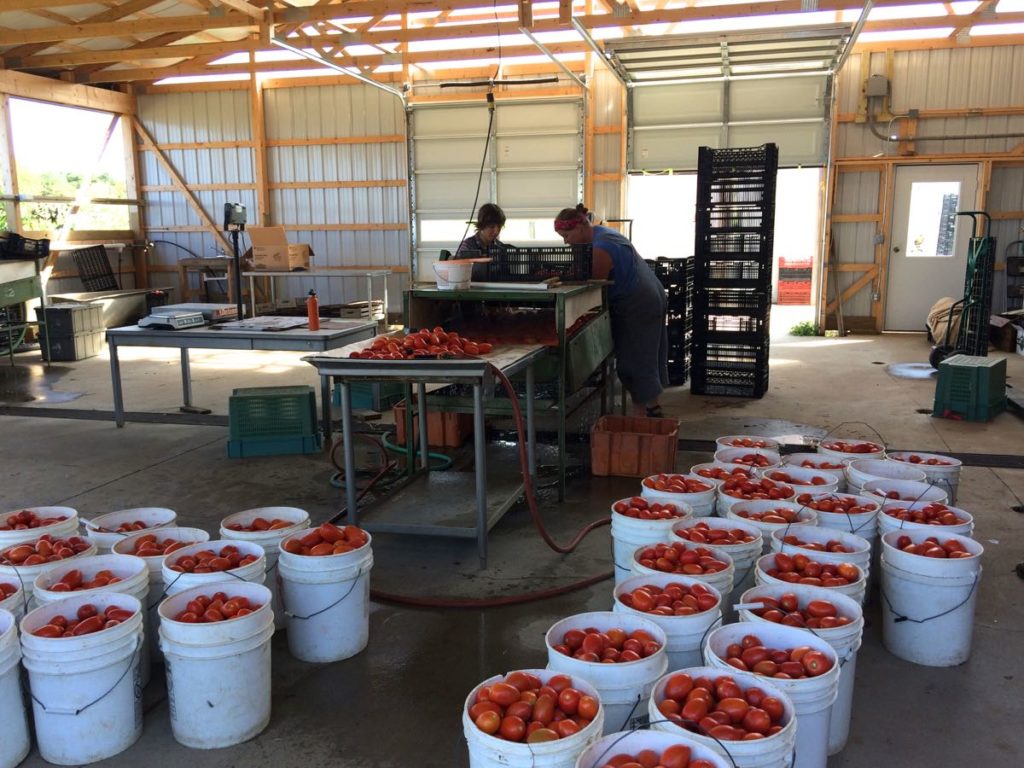
The tomatoes are still going strong. We can thank the dry weather for that. At top, Kerry and Kelsie wash plum tomatoes. The improved light in our new shed is wonderful. We’ve enjoyed it all season.
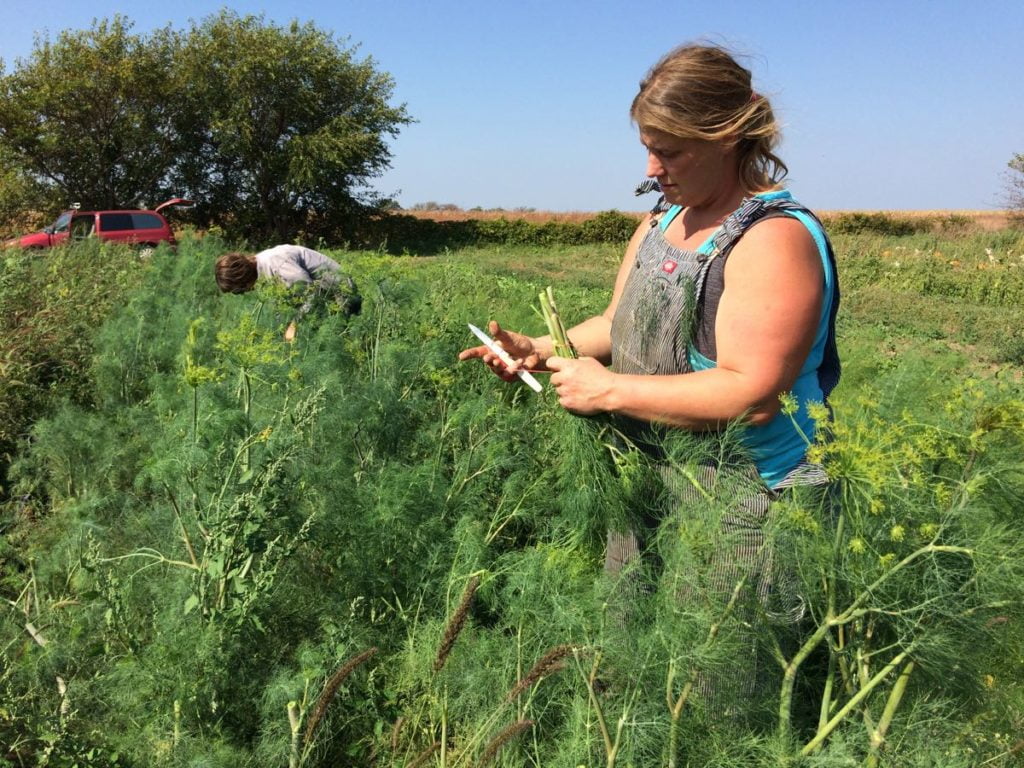
Charlotte and Maggie bundle dill for the CSA boxes.
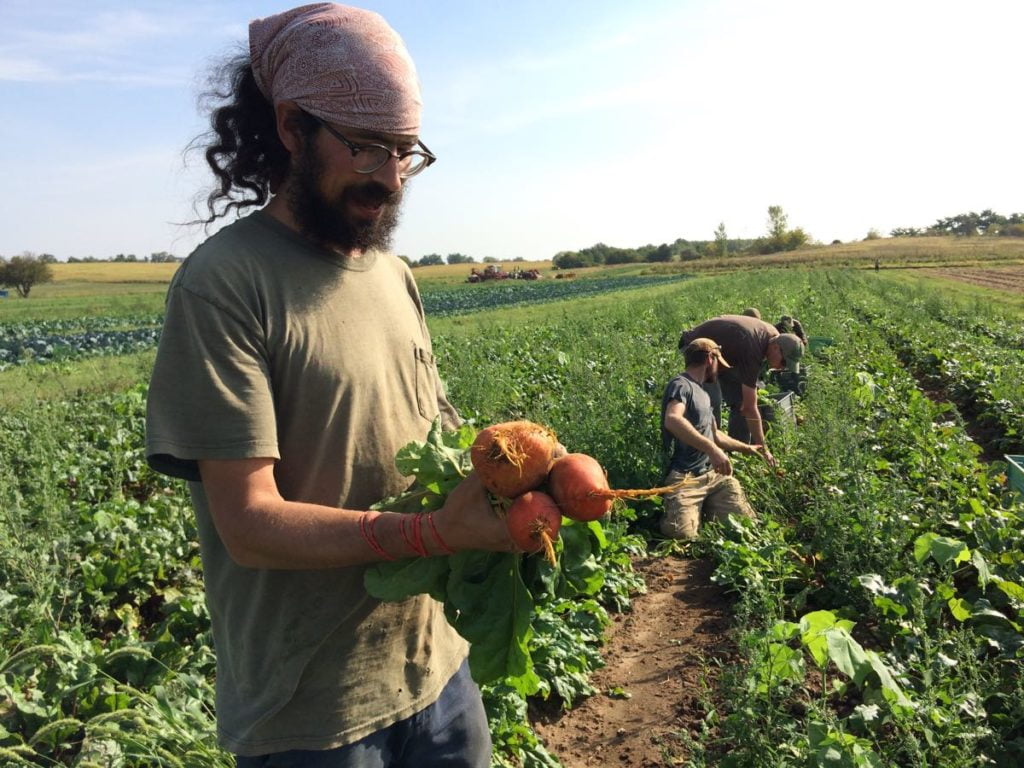
Small scale, big scale. Smitty, Billy, Matt, Jim, Jose, Raul and Kelsie bundle golden beets with the greens attached. We do this task by hand. Really, it’s the only way to do a quality job.
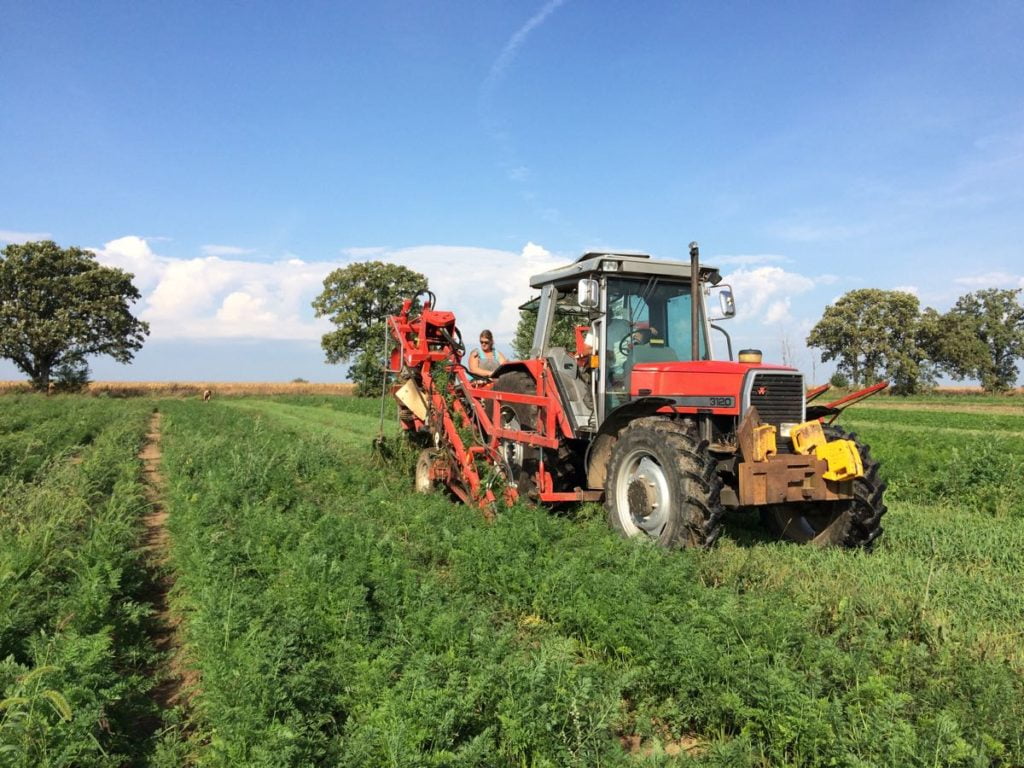
In a nearby field, Steve harvested carrots mechanically. With our root digger, we can harvest 1000 lb carrots in 30 minutes with just three people. Without this sort of tool we couldn’t grow enough carrots to feed you all winter.
WINTER SQUASH
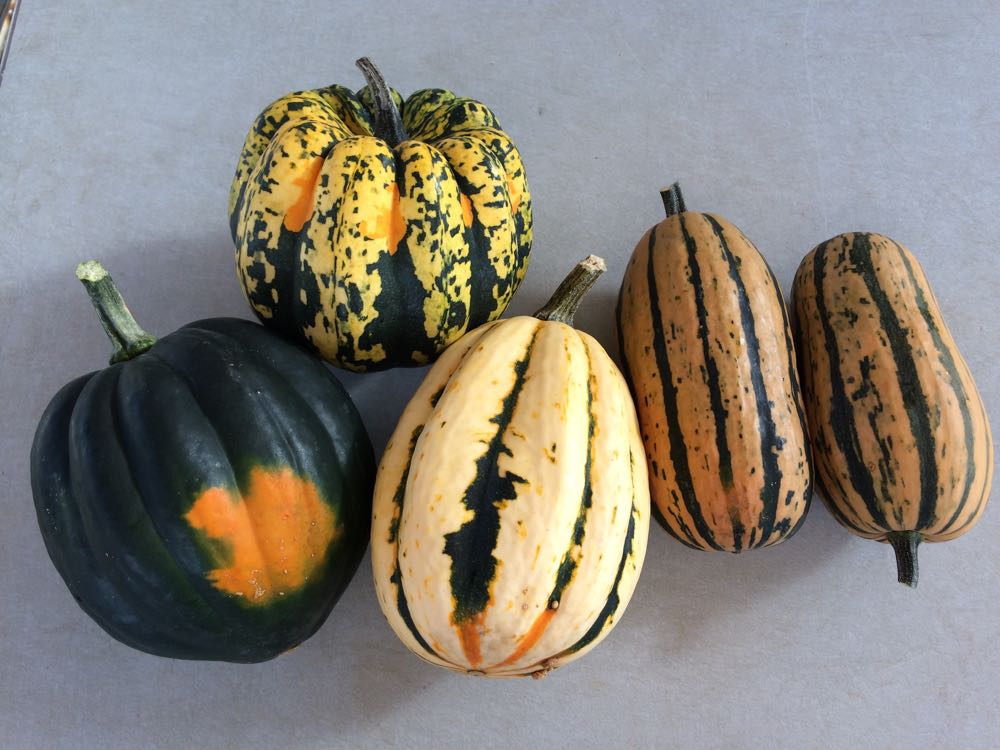
From left, TipTop acorn, Carnival acorn, Jester (an acorn x sweet dumpling hybrid), Honey Boat delicata (2/box).
We harvested a variety of early maturing types for this week’s box. You will receive one of these types. Some are new-ish varieties for us. We trial new varieties for a few years before scaling up and each of these types made the cut. I think these are all winners but I’d like to hear what you think of them. There’s a limit to how many I can sample!
Expected life: These acorn and delicata types do not store for long. Plan to eat within two weeks.
Storage: Store at room temperature, uncovered.
To make squash easier to cut: Microwave on high for 30 to 60 seconds, depending on size of the squash. This will soften the rind and flesh, making it much easier to cut.
Beth’s favorite simple preparation: Winter squash are easily roasted in a 400F oven. Microwave your squash to soften it. Split in half with a sharp knife. Scoop out and discard seeds. Run the squash under running water and shake off the excess water. Place cavity-side-down on an oiled baking sheet. The little bit of moisture helps seal the squash to your roasting pan. The water soon evaporates, allowing the squash to brown and caramelize. The caramelization really boosts the flavor. Roast at 400F until easily pierced with a fork, 20 – 45 minutes depending on size. Flip over while hot. Add a little butter to melt and some seasoned salt. Cut into wedges and eat.
Can you eat the rind? Well, Steve eats the rind for all these types but he’s a little crazy. In my opinion, the rinds are too thick to eat on the acorn types (TipTop, Jester, Carnival). Delicata skin is usually thin enough to eat but this durable Honey Boat variety has a somewhat thicker rind than usual. I don’t eat it; Steve does.
Stuffed squash: Each of this week’s types has a central cavity that can be stuffed. Prepare your favorite fully-cooked stuffing, e.g. a rice or quinoa mixture. Roast your squash as described above. Preheat the stuffing. Fill the cooked squash with stuffing, top with grated cheese and return to the oven until everything is hot.
Veggie List and Veggie Notes
Sept 21/22, 2017, week #19, purple EOW, moon Sampler
Beth’s box logic w.r.t. dill:
– Your dill will be a bundle of both flowers and leaves. Use the flowers to make a dilly-bean salad or some refrigerator dilly-beans, similar to refrigerator pickles.
– Dill leaves combine well with broccoli, so think about an egg-broccoli-dill dish, along the lines of a quiche or frittata.
– Cream of tomato soup with dill is really, really good. Use your favorite tomato-basil soup but substitute dill for the basil, and reduce the amount. Use a light hand with the dill if you’re planning to save soup for leftovers. Dill tends to strengthen over time in tomato soup.
Golden beets with greens, 1 bunch
Broccoli, 1 or 2 nice heads
Winter squash, 1 medium or 2 small, see notes
Tomatoes, slicing, ~2 lb
Tomatoes, plum, ~2 lb
(Both types are in one paper bag.)
Carrots, 2 lb
Green beans, ~0.7 lb
Red bell peppers, 2
Yellow onion
Dill, 1 bunch
Jalapeno chile (HOT), 1
Garlic
A few sites get an heirloom tomato or a cucumber or some extra beans.
Next week’s box will probably contain broccoli, potatoes, tomatoes, peppers, spinach and more.
Golden beets with greens – Beet greens are tasty, similar to Swiss chard in flavor, texture & cooking time. These two crops are very closely related. You can remove the thickest midribs before cooking if you wish, but it is not essential. Storage: Cover and refrigerate. Separate the tops and roots if you don’t plan to eat the greens immediately, to preserve freshness in the roots. Beet greens are perishable and should be eaten soon. The beet roots will last for weeks.
Broccoli – 2017 continues to be a good broccoli year. Broccoli needs a lot of water at its adolescent stage and this planting certainly got it this summer.
Yellow onion – This week’s onion is an intermediate type which will fry successfully yet is not as pungent as a typical yellow storage onion.
Dill – You’ll get a bundle with both flowers and leaves. Ideas: See above.
Winter squash – See above.
RECIPES
Visit our Recipe Log, a list of all our 2017 recipes.
RECIPES FROM LOCAL THYME
Comforting Classics
Golden Beets with Citrus and Greens
A Hungarian Goulash
Asian Stir Fry with Broccoli, Peppers, Beet Greens and Beef
Baked Winter Squash with Tomatoes
Outside the Box Recipes
Farro Salad with Beets, Broccoli, Dill and Walnuts
Orange Scented Pork with Tomatoes and Onions
Black Bean, Broccoli and Cheese Stuffed Bell Peppers
Winter Squash Agrodolce
Quick and Easy Meal
Black Bean, Shredded Carrot and Pepper Burrito

